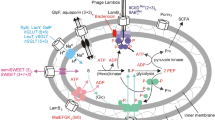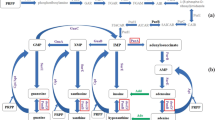Abstract
Streptococcus mutans Ingbritt was grown in glucose-excess continuous culture to repress the glucose phosphoenolpyruvate phosphotransferase system (PTS) and allow investigation of the alternative glucose process using the non-PTS substrate, (3H) 6-deoxyglucose. After correcting for non-specific adsorption to inactivated cells, the radiolabelled glucose analogue was found to be concentrated approximately 4.3-fold intracellularly by bacteria incubated in 100 mM Tris-citrate buffer, pH 7.0. Mercaptoethanol or KCl enhanced 6-deoxyglucose uptake, enabling it to be concentrated internally by at least 8-fold, but NaCl was inhibitory to its transport. Initial uptake was antagonised by glucose but not 2-deoxyglucose. Evidence that 6-deoxyglucose transport was driven by protonmotive force (Δp) was obtained by inhibiting its uptake with the protonophores, 2,4-dinitrophenol, carbonylcyanide m-chlorophenylhydrazine, gramicidin and nigericin, and the electrical potential difference (ΔΨ) dissipator, KSCN. The membrane ATPase inhibitor, N,N1-dicyclohexyl carbodiimide, also reduced 6-deoxyglucose uptake as did 100 mM lactate. In combination, these two inhibitors completely abolished 6-deoxyglucose transport. This suggests that the driving force for 6-deoxyglucose uptake is electrogenic, involving both the transmembrane pH gradient (ΔpH) and ΔΨ. ATP hydrolysis, catalysed by the ATPase, and lactate excretion might be important contributors to ΔpH.
Similar content being viewed by others
Abbreviations
- DNP:
-
2,4-dinitrophenol
- CCCP:
-
carbonylcyanide m-chlorophenylhydrazone
- DCCD:
-
N,N1-dicyclohyxyl carbodiimide
- Δp:
-
protonmotive force
- ΔpH:
-
transmembrane pH gradient
- ΔΨ:
-
transmembrane electrical potential difference
References
Bakker EP, Mangerich WE (1981) Interconversion of components of the bacterial proton motive force by electrogenic potassium transport. J Bacteriol 147:820–826
Carlsson J (1970) Nutritional requirement of Streptococcus mutans. Caries Res 4:305–320
Da Costa T, Gibbons RJ (1968) Hydrolysis of levan by human streptococci. Arch Oral Biol 13:609–617
Dische Z, Shettles LB (1948) A specific colour reaction of methylpentoses and a spectrophotometric micromethod for their determination. J Biol Chem 175:595–603
Eisenberg DA, Bender GR, Marquis RE (1980) Reduction in the aciduric properties of the oral bacterium Streptococcus mutans GS-5 by fluoride. Arch Oral Biol 25:133–135
Ellwood DC, Phipps PJ, Hamilton IR (1979) Effect of growth rate and glucose concentration on the activity of the phosphoenolpyruvate phosphotransferase system in Streptococcus mutants Ingbritt grown in continuous culture. Infect Immun 23:244–231
Ellwood DC, Keevil CW, Marsh PD, Brown CM, Wardell JN (1982) Surface-associated growth. Phil Trans Royal Soc London B 297:517–532
Gibbons RJ, van Houte J (1975) Bacterial adherence in oral microbial ecology. Ann Rev Microbiol 29:19–44
Hamilton IR, Ellwood DC (1987) Effects of fluoride on carbohydrate metabolism by washed cells of Streptococcus mutans grown at various pH values in a chemostat. Infect Immun 19:434–442
Hamilton IR, Keevil CW (1985) Relationship of protomotive force to glucose metabolism by Streptococcus mutans. J Dent Res 64:195
Hamilton IR, Ng KC (1983) Stimulation of glycolysis through lactate consumption in a resting cell mixture of Streptococcus salivarius and Veillonella parvula. FEMS Microbiol Lett 20:61–65
Hamilton IR, St. Martin EJ (1982) Evidence for the involvement of protonmotive force in the transport of glucose by a mutant of Streptococcus mutans strain DR0001 defective in glucose-phosphoenolpyruvate phosphotransferase activity. Infect Immun 36:567–575
Hardie JM, Bowden GH (1976) Physiological classification of oral viridans streptococci. J Dent Res 55:A 116-A 176
Harold FM (1972) Novel antibiotics as metabolic inhibitors. In: Hochster RM, Kates M, Quastel JH (eds) Metabolic inhibitors, vol 3, A comprehensive treatise. Academic Press, New York London, pp 305–360
Harold FM (1977) Membranes and energy transduction in bacteria. In: Sanadi DR (ed) Current topics in bioenergetics, vol 6. Academic Press, New York London, pp 83–149
Harris PJ, Northcote DH (1970) Patterns of polysaccharide biosynthesis in differentiating cells of maize root-tips. Biochem J 120:479–491
Heefner DL (1982) Transport of H+, K+, Na+ and Ca2+ in Streptococcus. Mol Cell Biochem 44:81–106
Herbert D, Phipps PJ, Tempest DW (1965) The chemostat: design and instrumentation. Lab Pract 14:1150–1161
Hojo S, Higuchi M, Araya S (1976) Glucan inhibition of diffusion in plaque. J Dent Res 55:169
Kashket ER, Barker SL (1977) Effects of potassium ions on the electrical and pH gradients across the membrane of Streptococcus lactis cells. J Bacteriol 130:1017–1023
Kashket ER, Blanchard AG, Metzger WC (1980) Protonmotive force during growth of Streptococcus lactis cells. J Bacteriol 143:128–134
Keevil CW, Hamilton IR (1984a) Comparison of polyvinyl chloride membrane electrodes sensitive to alkylphosphonium ions for the determination of the electrical different (ΔΨ) of Streptococcus mutans and Lactobacillus casei. Anal Biochem 139:228–236
Keevil CW, Hamilton IR (1984b) Influence of Na+ and K+ on generation of protonmotive force and glucose uptake and metabolism in oral bacteria. J Dent Res 63:495
Keevil CW, Williamson MI, Marsh PD, Ellwood DC (1981) An alternative sugar transport uptake system in oral streptococci involving a protonmotive force. Soc Gen Microbiol Quart 8:118
Keevil CW, West AA, Bourne N, Marsh PD (1983) Synthesis of a fructosyltransferase by Streptococcus sanguis. FEMS Microbiol Lett 20:155–157
Keevil CW, Marsh PD, Ellwood DC (1984a) Regulation of glucose metabolism in oral streptococci through independent pathways of glucose 6-phosphate and glucose 1-phosphate formation. J Bacteriol 157:560–567
Keevil CW, West AA, Bourne N, Marsh PD (1984b) Inhibition of the synthesis and secretion of extracellular glucosyl- and fructosyltransferase in Streptococcus sanguis by sodium ions. J Gen Microbiol 130:77–82
Keevil CW, Williamson MI, Marsh PD, Ellwood DC (1984c) Evidence that glucose and sucrose uptake in oral streptococci involves independent phosphotransferase and protonmotive force-mediated mechanisms. Arch Oral Biol 29:871–878
Marsh PD, Williamson MI, Keevil CW, McDermid AS, Ellwood DC (1982) Influence of sodium and potassium on acid production by washed cells of Streptococcus mutans Ingbritt and Streptococcus sanguis NCTC 7865 grown in a chemostat. Infect Immun 36:476–483
Marsh PD, Keevil CW, McDermid AS, Williamson MI, Ellwood DC (1983) Inhibition by chlorhexidine of acid production and sugar transport in oral streptococci. Arch Oral Biol 28:233–240
Marsh PD, Keevil CW, Ellwood DC (1984) Relationship of bioenergetic processes to the pathogenic properties of oral bacteria. J Dent Res 63:401–406
Michels PAM, Michels JPJ, Boonstra T, Konings WN (1979) Generation of an electrochemical proton gradient in bacteria by the excretion of metabolic end products. FEMS Microbiol Lett 5:357–364
Mitchell P (1961) Coupling of phosphorylation to electron and hydrogen transfer by a chemiosmotic type of mechanism. Nature (Lond) 191:144–148
Mitchell P (1966) Chemiosmotic coupling in oxidative and photosynthetic phosphorylation. Biol Rev 41:445–502
Otto R, Sonnenberg SAM, Veldkamp H, Konings WN (1980) Generation of an electrochemical proton gradient in Streptococcus cremoris by lactate efflux. Proc Natl Acad Sci USA 77:5502–5506
Schachtele CF (1975) Glucose transport in Streptococcus mutans: preparation of cytoplasmic membranes and characteristics of phosphotransferase activity. J Dent Res 54:330–338
Schachtele CF, Mayo JA (1973) Phosphoenolpyruvate-dependent glucose transport in oral streptococci. J Dent Res 52:1209–1215
Simpson SJ, Vonk R, Egan AF, Rogers PJ (1983) Lactate efflux stimulates (32Pi) ATP exchange in Streptococcus faecalis membrane vesicles. FEMS Microbiol Lett 19:111–114
Solioz M (1984) Dicyclohexylcarbodiimide as a probe for proton translocating enzymes. Trends Biochem Sci 9:309–312
Stock J, Roseman S (1971) A sodium dependent sugar transport cosystem in bacteria. Biochem Biophys Res Com 44: 132–138
Tatevossian A, Gould CT (1976) The composition of the aqueous phase in human dental plaque. Arch Oral Biol 21:319–323
ten Brink B, Konings WN (1982) The electrochemical proton gradient and lactate concentration gradient in Streptococcus cremoris grown in batch culture. J Bacteriol 152:682–686
Thomson J, Chassy BM (1982) Novel phosphoenolpyruvate-dependent futile cycle in Streptococcus lactis: 2-deoxy-D-glucose uncouples energy production from growth. J Bacteriol 151:1454–1465
Tsuchiya TJ, Raven J, Wilson TH (1977) Co-transport of Na+ and methyl-β-D-thiogalactopyranoside mediated by the melibiose transport system of Escherichia coli. Biochem Biophys Res Com 76:26–31
Vadeboncoeur CD, Trahan L (1982) Glucose transport in Streptococcus salivarius. Evidence for the presence of a distinct phosphoenolpyruvate:glucose phosphotransferase system which catalyses the phosphorylation of a α-methyl glucoside. Can J Microbiol 28:190–199
West AA, Keevil CW, Marsh PD, Ellwood DC (1984) The effect of ionophores on growth and glycosyltransferase production of Streptococcus sanguis. FEMS Microbiol Lett 25:133–137
Author information
Authors and Affiliations
Rights and permissions
About this article
Cite this article
Keevil, C.W., McDermid, A.S., Marsh, P.D. et al. Protonmotive force driven 6-deoxyglucose uptake by the oral pathogen, Streptococcus mutans Ingbritt. Arch. Microbiol. 146, 118–124 (1986). https://doi.org/10.1007/BF00402337
Received:
Accepted:
Issue Date:
DOI: https://doi.org/10.1007/BF00402337




